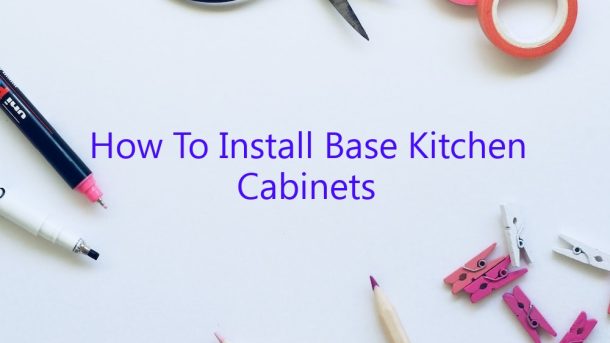Installing kitchen cabinets is a big project, but it’s a project that you can complete yourself with a little bit of patience and some basic carpentry skills. In this article, we’ll show you how to install base kitchen cabinets.
To install kitchen cabinets, you’ll need the following supplies:
-Carpenter’s level
-Circular saw
-Cordless drill
-Drill bits
-Framing square
-Hammer
-High-grit sandpaper
-Jigsaw
-Paintable silicone caulk
-Paintbrush
-Plywood
-Ruler or tape measure
-Safety glasses
-Socket set
-Tape measure
-Wood glue
You’ll also need to have a basic understanding of carpentry and cabinet installation. If you don’t have any experience with carpentry, we recommend reading a few basic tutorials before starting this project.
Now that you have all of the supplies and tools you need, let’s get started on the installation.
1. Remove the old cabinet doors and drawer fronts.
The first step in installing kitchen cabinets is to remove the old cabinet doors and drawer fronts. This can be a bit tricky, so be careful not to damage the walls or cabinets.
If the cabinet doors are attached with screws, use a screwdriver to remove them. If the doors are attached with hinges, use a hammer to knock the pins out of the hinges.
Once the cabinet doors and drawer fronts are removed, set them aside in a safe place.
2. Measure the space where the new cabinets will be installed.
Before you start installing the cabinets, it’s important to measure the space where they will be installed. This will ensure that you order the right size cabinets.
Measure the height, width, and depth of the space, and write down the measurements.
3. Cut the plywood to size.
Next, you’ll need to cut the plywood to size. This will be the base for your cabinets.
Measure the plywood to fit the space, and then use a circular saw to cut it to size.
4. Install the cleats.
The cleats are what will hold the cabinets in place. They need to be installed in a stud, so be sure to check for studs before you start installing them.
If there are no studs in the space, you can use anchors to install the cleats.
Use a level to make sure the cleats are level, and then use a drill to drill pilot holes in the plywood.
attach the cleats to the plywood with screws.
5. Install the cabinet carcasses.
Now it’s time to install the cabinet carcasses. This is the frame of the cabinet.
align the cabinet carcasses with the cleats, and then use a drill to drill pilot holes in the cabinet.
attach the cabinet carcasses to the cleats with screws.
6. Install the cabinet doors and drawer fronts.
Now that the cabinet carcasses are installed, you can install the cabinet doors and drawer fronts.
align the cabinet doors and drawer fronts with the cabinet carcasses, and then use a drill to drill pilot holes in the cabinet.
attach the cabinet doors and drawer fronts to the cabinet carcasses with screws.
7. Caulk the seams.
Once the cabinet doors and drawer fronts are installed, use a paintbrush to apply caulk to the seams. This will seal the seams and make them watertight
Contents
How do you install bottom base cabinets?
Installing bottom base cabinets is a pretty straightforward process, but there are a few things you need to know before you get started. In this article, we’ll walk you through the steps involved in installing a bottom base cabinet.
First, you’ll need to measure the space where you plan to install the cabinet. Make sure to measure the height, width, and depth of the space, and take into account any existing cabinets or fixtures that may be in the way.
Once you have the measurements, you’ll need to decide on the height of the cabinet. Most bottom base cabinets are 24 inches high, but you may want to choose a different height if it will be easier to fit your specific space.
Next, you’ll need to decide on the style and configuration of the cabinet. There are a variety of different styles and configurations to choose from, so you should be able to find one that will fit your needs.
Once you’ve chosen the style and configuration of the cabinet, you’ll need to decide on the type of cabinet you want. There are three main types of cabinets: base, wall, and tall. Base cabinets are the most common type, and they are typically installed as part of a kitchen or bathroom renovation. Wall cabinets are typically used to store items in a garage or workshop, and tall cabinets are used to store items in a closet or pantry.
Once you’ve chosen the type of cabinet, you’ll need to choose the color and finish. Most cabinets come in a variety of colors and finishes, so you should be able to find one that will match your décor.
Once you’ve chosen all of the details of the cabinet, you’ll need to prepare the space for installation. Make sure the space is cleared and level, and that there are no obstructions in the way.
Now it’s time to install the cabinet. Begin by marking the location of the cabinet on the wall. Use a level to make sure the marks are straight, and then use a drill to make pilot holes.
Next, use a screwdriver to install the cabinet’s mounting brackets. Make sure the brackets are installed in the correct location, and then use a drill to attach them to the wall.
Now it’s time to install the cabinet. Align the cabinet with the markings on the wall, and then use a drill to attach it to the mounting brackets. Be sure to use the correct screws and drill bit size, or you may damage the cabinet.
Once the cabinet is installed, you’ll need to install the countertop. Most countertops can be installed using a few simple tools, so you should be able to do it yourself.
That’s it! You’ve now installed a bottom base cabinet.
Are base cabinets attached to the floor?
Are base cabinets attached to the floor?
Base cabinets are not typically attached to the floor, but they can be. A base cabinet is a cabinet that sits on the floor and typically has a countertop on top. Some people choose to attach their base cabinets to the floor in order to ensure that they do not move or wobble.
There are a few ways to attach a base cabinet to the floor. One way is to use screws or nails to attach it to the floor. Another way is to use brackets or cleats to attach it to the floor.
If you choose to attach your base cabinet to the floor, you will need to make sure that it is level. You can use a level to check the level of the cabinet. You will also need to make sure that the cabinet is securely attached to the floor.
If you are not sure how to attach your base cabinet to the floor, you can consult a professional. A professional can help you choose the right method to attach the cabinet to the floor and can ensure that the cabinet is level and secure.
Can I install base cabinets myself?
Installing base cabinets is a big job, but it’s a job that you can do yourself with a little bit of know-how. Here’s a guide on how to install base cabinets like a pro.
First, you’ll need to measure the space where you want to install the cabinets. Make sure to measure the height, width, and depth of the space, and then add an inch to each dimension to allow for wiggle room.
Next, you’ll need to choose the cabinets that you want to install. Make sure to select cabinets that are the right size for the space.
Once you have the cabinets, you’ll need to assemble them. Follow the instructions that come with the cabinets, and make sure to use a level when you’re assembling them.
Once the cabinets are assembled, it’s time to install them in the space. Make sure to measure the space accurately and mark the spots where you want to install the cabinets. Use a drill to make pilot holes in the wall, and then use a screwdriver to install the cabinets.
Make sure to use a level when installing the cabinets, and also make sure to install them straight. If you’re not confident in your ability to install the cabinets straight, you may want to hire a professional to do the job for you.
Once the cabinets are installed, it’s time to add the hardware. Follow the instructions that come with the hardware, and make sure to install it properly.
Once the hardware is installed, it’s time to put things in the cabinets. Start with the heaviest items and work your way down. Make sure to pack the cabinets tightly, and leave no space between the items.
Once everything is in the cabinets, it’s time to take a step back and admire your work. Congratulations, you’ve just installed your cabinets like a pro!
Do you screw base cabinets to the wall?
Do you screw base cabinets to the wall?
Base cabinets can be secured to the wall in a few different ways. One way is to screw them directly to the wall studs. Another way is to use a cabinet mounting bracket.
If you are going to screw the cabinets directly to the wall studs, you will need to find the wall studs and mark them on the cabinet. The studs are usually 16 inches apart, so you will want to mark the cabinet at 16-inch intervals. Use a stud finder to locate the studs and then mark them with a pencil.
Once you have marked the location of the wall studs, use a drill to make pilot holes in the cabinet. Make sure the drill bit is the same size as the screws that you will be using. Then, use a screwdriver to drive the screws into the wall studs.
If you are using a cabinet mounting bracket, you will need to mark the location of the bracket on the cabinet. The bracket will usually have two holes that you will need to mark on the cabinet. Use a drill to make pilot holes in the cabinet and then use a screwdriver to drive the screws into the cabinet.
If you are using a cabinet mounting bracket, make sure the bracket is the same size as the cabinet. The bracket should also be the same size as the wall studs.
Do kitchen cabinets sit on subfloor?
Do kitchen cabinets sit on subfloor? This is a question that many homeowners have. The answer is it depends on the cabinet.
Some kitchen cabinets rest on the subflooring while others are mounted to the wall. If you have a cabinet that sits on the subfloor, it is important to make sure that the floor is level and stable before mounting it.
If the subfloor is not level, you may need to add shims to create a level surface. You can also use a level to check the surface before mounting the cabinet.
If you are not sure whether your cabinet sits on the subfloor, you can check the manufacturer’s instructions or contact the retailer where you purchased the cabinet.
It is also important to make sure that the cabinet is properly secured to the wall. Many cabinets come with mounting hardware that screws into the wall.
If your cabinet does not come with mounting hardware, you can use a drill and screws to attach it to the wall. Make sure that the screws are long enough to secure the cabinet to the wall.
If you are not sure how to install your cabinet, you can contact a professional to help you.
Where do you start base cabinets?
Base cabinets provide essential storage in the kitchen. They can be used to store dishes, pots and pans, or any other kitchen items. Base cabinets come in a variety of sizes, and it can be difficult to know where to start when choosing the right one for your kitchen.
The first step is to measure the space you have available for the cabinet. Be sure to measure both the height and the width of the space. This will help you to select a cabinet that will fit in the space.
Once you have measured the space, you can begin to choose the style of cabinet that you want. There are many different styles to choose from, and you can select one that will match the decor of your kitchen.
Once you have selected the style of cabinet, you need to decide on the size. Be sure to choose a cabinet that will fit in the space, and that will also provide the storage that you need.
Once you have selected the size and style of cabinet, you need to select the finish. There are many different finishes to choose from, and you can select one that will match the decor of your kitchen.
Once you have selected the size, style, and finish of the cabinet, you need to select the hardware. There are many different types of hardware to choose from, and you can select one that will match the decor of your kitchen.
Once you have selected the size, style, finish, and hardware of the cabinet, you need to select the countertop. There are many different types of countertops to choose from, and you can select one that will match the decor of your kitchen.
Once you have selected the size, style, finish, hardware, and countertop of the cabinet, you need to install it. be sure to follow the instructions that come with the cabinet.
Do hardwood floors go under kitchen cabinets?
Do hardwood floors go under kitchen cabinets?
This is a common question that many homeowners have. The answer to this question is it depends. If you have a floating hardwood floor, then the answer is no, you should not put kitchen cabinets on top of the flooring. If you have a hardwood floor that is nailed or glued to the subfloor, then you can put kitchen cabinets on top of the floor.
If you have a floating hardwood floor, it is best to avoid putting any weight on the flooring. This is because the flooring is not attached to the subfloor and can therefore become damaged or warped over time. If you put kitchen cabinets on top of the flooring, it will be more difficult to move them if you ever need to.
If you have a hardwood floor that is nailed or glued to the subfloor, you can put kitchen cabinets on top of the floor. However, you should take some precautions. First, you should make sure that the cabinets are not too heavy for the floor. You should also make sure that there is enough space between the cabinets and the walls so that the floor can expand and contract without becoming damaged.




